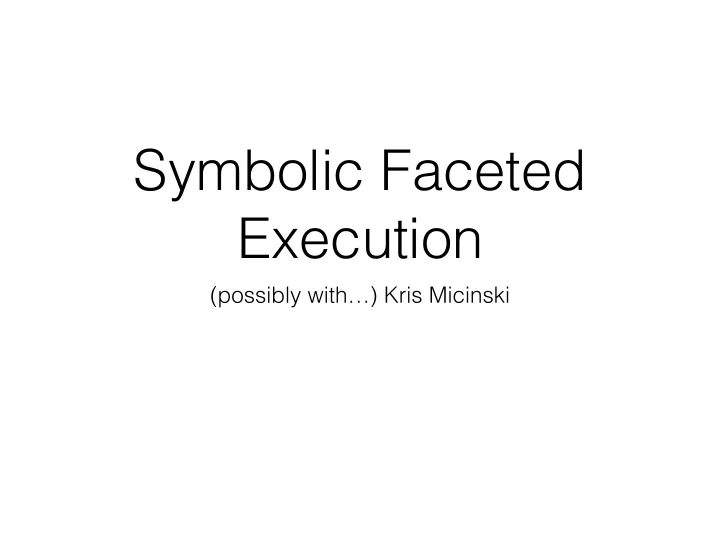

Symbolic Faceted Execution (possibly with…) Kris Micinski
What does the following function compute? True False function(x) { y = true; Let’s pretend the z = true; observer can see z… if (x) y = false if (y) z = false return z; } True False
Should be identity, but apply it to a private variable… Do you have prior medical conditions??? Thread 1: function(x) { y = true; z = true; if (x) Thread 2: y = false send(insurer,z); if (y) z = false return z; }
Ways to tame this • For a “public” observer: • Pretend that the input x was NULL ( ⊥ ) • Run the program and propagate ⊥ • For a “private” observer, run program in separate addr space • Run the program twice • Give public view to public (when sending network data) • Keep the private view inside
Running with ⊥ function( ⊥ ) { y = true; z = true; Treat ⊥ as false if ( ⊥ ) y = false I get False no matter what … if (y) z = false return z; } False
Private Public Public sees computation as if it had no secret input
Multiple principles Code from lots of different people running in same browser (mashups)
Execute multiple copies • Need to execute multiple copies of program • So z stays distinct for the rest of execution • Now consider we have more than just one observer • Facebook, Yahoo Ads, and random.com ads • Now need to execute many copies of program • Doesn’t scale very well! (In general 2 n )
Faceted execution • Key concept: proxy data with tags • (principal, private view, low view) • If I’m principal k, I see the result V h otherwise I see V l { k | V h , V l } Principal (e.g., FB , foo.com) The way k sees the result of the computation The way the rest of the world sees the computation
function(x = <FB | true , ⊥ >) { y = true; z = true; if (x) y = false if (y) z = false return z; }
function(x = <FB | true , ⊥ >) { y = true; What happens here z = true; if (x) y = false Execute twice : if (y) • Once for private facet z = false • Once for public facet return z; • join back together } Private Public • x is false ( ⊥ ) • x is true • y is false • y is true Join them! y becomes <FB | false , true>
function(x = <FB | true , ⊥ >) { y = true; z = true; if (x) Apply trick again… y = false if (<FB | false, true>) z = false return z; } after if z = <FB | true, false>
Using faceted values • Imagine some malicious code tries to send out z • Should see computation as if private inputs were ⊥ • Use projection : send(foo.com, z = <FB | true, false>) NO! � Check to see if foo.com is FB false
• This is a simple trick that solves a big problem • Some technical details I can help you figure out • But works pretty well! • Also supports declassification � • Potential research: • might propagate facet to place where it isn’t needed � • Can eliminate facet that is of form < k | v 1 , v 1 > � • Also places where facet is never projected?
Silly example of when facets are unnecessary… function(x = <FB | v , ⊥ >) { y = true; if (x+x-2*x = 0) y = true else y = false return <FB | false , false>; } Probably gets more interesting with more interesting domains / higher order control flow…
Your project • Read and figure out the faceted execution paper • Implement faceted execution in Redex • Research: eliminate unnecessary facets • Use symbolic execution to prove agreement � • Show on various examples � • Prove implementation is correct • Extend actual implementation
Thanks! • I look forward to talking to you about this! • Please talk to me if you’re interested
Recommend
More recommend